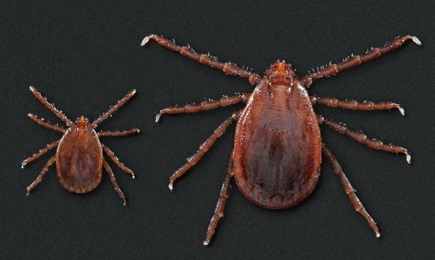



Springtime brings tick risks to people and cattle alike
The Asian Longhorned Tick (ALT) has been identified in at least 18 US states; rapid explosions of this tick can be detrimental to cattle
The arrival of springtime begins a busy season around the farm, but it also marks the beginning of the tick season. In Pennsylvania, tick-borne disease is a well-known problem in people and pets but tick-related concerns in cattle are growing thanks to the invasive Asian Longhorned Tick (ALT, Haemaphysalis longicorinis).
The ALT was first recognized in the United States in 2017 (Rainey et al., 2017). Since that time, it has been identified in at least 18 states, including Pennsylvania and all neighboring states, based on a USDA map that tracks the spread of this invasive species. This tick is unique because it is parthenogenic, meaning it does not need a male to reproduce. A single parthenogenic female transported to a new location can start a new population that can grow rapidly because all ticks born are female and can produce eggs.
These rapid population explosions can be detrimental to cattle. In Australia and New Zealand, where invasive ALT populations have been present for many years, severe infestations have been reported to cause milk production losses and even death from blood loss (Heath, 2016). However, the risk of the ALT to cattle goes beyond its direct effects. This tick can also vector the blood parasite Theileria orientalis genotype Ikeda, which can cause disease in cattle.
The first U.S. case report of Theileria associated bovine anemia (TABA), the disease caused by this parasite, describes the deaths of 7 cattle across multiple age groups on a single cow/calf operation. These deaths were initially suspected, based on disease signs, to be bovine anaplasmosis, a disease that presents similarly to TABA. When an 8th animal became ill, more in-depth diagnostics were undertaken and TABA was diagnosed for the first time in the U.S. (Oakes et al., 2019).
This disease is characterized by weak, lethargic cattle, often with a fever. There are no vaccines available to prevent TABA and no treatments, aside from supportive care, once cattle do get ill. Although few cases of TABA have been reported in Pennsylvania, producers should start taking steps now to protect their herd from the ALT.
Tick exposure occurs when cattle are outdoors, so those housed in confinement are at minimal risk of ALT and TABA. For cattle that do spend time on pasture, it is important to understand whether the ALT is present in the area or not.
The ALT has been identified in southeastern and southwestern PA, as well as Centre County, as of April 2023, but it may be more widespread across the state. Increased monitoring for the ALT can help better understand its true range and where cattle may be at risk. Any time pastured cattle are handled is an opportunity to check for ticks.
Ticks prefer thin-skinned areas and can often be found on the ears, under the jaw, or under the front legs. If ticks are found on pastured cattle, they can be removed and submitted to the Penn State Extension Insect Identification Laboratory for identification. When ALT or any ticks are identified on cattle, additional steps to protect cattle from tick bites can be taken.
Ticks prefer tall grasses and brushy areas where they quest or sit and wait for prospective hosts, like cattle, to pass by. Fencing cattle out of brushy areas and keeping pastures mowed can help reduce exposure to questing ticks. A good fly control program can also help reduce tick bites. Although there are currently no products for cattle specifically labeled for the ALT, many products will likely help prevent tick bites.
Several spray and pour-on fly products were recently tested against the ALT. Under laboratory conditions, all tested products effectively killed the ALT at labeled concentrations (Butler et al., 2021). If these measures still do not effectively manage ALT populations, additional steps can be taken, such as maintaining a mowed buffer around pastures.
Although identifying the spread of the ALT and protecting cattle from tick bites is important, protecting people from ticks is also critical during this high-risk season. Pennsylvania is home to ticks carrying the pathogens that cause multiple human diseases, including Lyme disease, babesiosis, and anaplasmosis (a different pathogen than what causes bovine anaplasmosis).
Avoiding brushy areas and tall grasses, using tick sprays, such as those containing DEET, and treating clothing with permethrin can help reduce the risk of tick bites. After spending time outdoors, it is important to conduct a thorough tick check to remove any ticks that may have gotten past other tick prevention measures. Tick season is a risky time of year for both people and cattle. Amongst all the other items on the springtime to-do list, it is important to keep an eye out for the ALT and to take steps to prevent tick bites for people and cattle alike.
References:
Butler, R. A., J. G. Chandler, K. M. Vail, C. J. Holderman, R. T. Trout Fryxell. "Spray and Pour-On Acaricides Killed Tennessee (United States) Field-Collected Haemaphysalis longicornis Nymphs (Acari: Ixodidae) in Laboratory Bioassays." J. Med. Entomology, Vol. 58, Issue 6 (Nov 2021):2514–2518.
Heath, A. "Biology, Ecology and Distribution of the Tick, Haemaphysalis Longicornis Neumann (Acari: Ixodidae) in New Zealand." [In eng]. N Z Vet J 64, no. 1 (Jan 2016): 10-20.
Oakes, V. J., M. J. Yabsley, D. Schwartz, T. LeRoith, C. Bissett, C. Broaddus, J. L. Schlater, et al. "Theileria Orientalis Ikeda Genotype in Cattle, Virginia, USA." [In eng]. Emerg Infect Dis 25, no. 9 (Sep 2019): 1653-59.
Rainey, T., J. L. Occi, R. G. Robbins, and A. Egizi. "Discovery of Haemaphysalis Longicornis (Ixodida: Ixodidae) Parasitizing a Sheep in New Jersey, United States." [In eng]. J Med Entomol 55, no. 3 (May 4 2018): 757-59.


